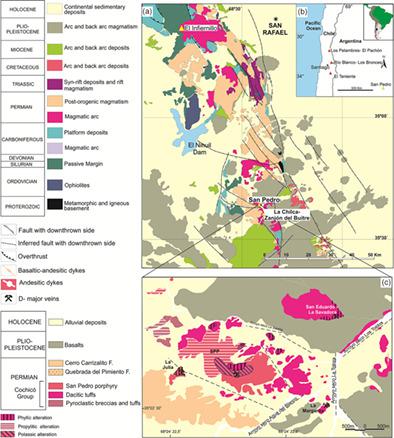当前位置:
X-MOL 学术
›
Resour. Geol.
›
论文详情
Our official English website, www.x-mol.net, welcomes your feedback! (Note: you will need to create a separate account there.)
The magmatic–hydrothermal evolution of the San Pedro porphyry Cu‐(Mo) deposit: Implications for the metallogenesis of the Permian magmatism in the western margin of Gondwana
Resource Geology ( IF 1.4 ) Pub Date : 2021-01-14 , DOI: 10.1111/rge.12251 Anabel Lina Rosina Gómez 1 , Thomas Ulrich 2 , Nora Alicia Rubinstein 1
Resource Geology ( IF 1.4 ) Pub Date : 2021-01-14 , DOI: 10.1111/rge.12251 Anabel Lina Rosina Gómez 1 , Thomas Ulrich 2 , Nora Alicia Rubinstein 1
Affiliation

|
The San Pedro porphyry Cu‐(Mo) deposit, located in the San Rafael Massif (Argentina), is characterized by multiple stockwork vein generations developed in a subvolcanic intrusion with porphyry‐type alteration and mineralization, as well as associated polymetallic veins. Previous works reveal that the intrusive rocks related to the San Pedro porphyry (263 Ma) show comparable trace element signatures to giant porphyry deposits elsewhere (i.e., high Sr/Y and low Y). The fluid inclusions investigated in this study show that typical early, high‐temperature magmatic fluids (up to 685°C; 81.3 wt% equiv. NaCl) evolved to lower‐temperature, moderately saline fluids (up to 454°C; 52.4 wt% equiv. NaCl) due to fluid–rock interaction. The waning stage of the system is characterized by secondary, aqueous inclusions that represent dilution by meteoric fluids (up to 390°C, 16.9 wt% equiv. NaCl). Fluid inclusions were studied from two veinlet generations (A and B veinlets) related to potassic alteration and analyzed by LA‐ICP‐MS. The trace element signatures in the fluid inclusions suggest that there were two pulses of magmatic fluids that subsequently evolved under similar physicochemical conditions. The Cu concentration in the earliest fluid is between 0.3 and 0.85 wt% and within the concentrations found in other mineralized porphyry systems in the world. However, in contrast to economic porphyry systems, where a significant change in Cu concentration during fluid evolution is observed, there is no distinct change in the fluid Cu concentration at the San Pedro deposit, which would indicate that Cu and Mo precipitation was ineffective in the hydrothermal system.
中文翻译:

San Pedro斑岩Cu-(Mo)矿床的岩浆-水热演化:对冈瓦纳西部边缘的二叠纪岩浆作用的成矿意义
位于圣拉斐尔地块(阿根廷)的San Pedro斑岩Cu-(Mo)矿床的特征是在斑岩型蚀变和矿化作用以及伴生的多金属矿脉的次火山侵入中发育了多个储层脉代。先前的研究表明,与圣佩德罗斑岩(263 Ma)有关的侵入岩显示出与其他地方的斑岩斑岩(即高Sr / Y和低Y)相当的微量元素特征。在这项研究中研究的流体包裹体表明,典型的早期高温岩浆流体(最高685°C;当量NaCl的81.3 wt%)演变为温度较低的中等盐度的流体(最高454°C; 52.4 wt%)相当于氯化钠),这是由于流体与岩石的相互作用所致。该系统的衰落阶段的特征是次要的,代表被流星流体稀释的水性夹杂物(最高390°C,16.9 wt%当量的NaCl)。研究了与钾质改变有关的两个小脉代(A和B小脉)中的流体包裹体,并通过LA-ICP-MS进行了分析。流体包裹体中的痕量元素特征表明存在两个岩浆流体脉冲,随后在相似的物理化学条件下演化。最早的流体中的铜浓度在0.3至0.85 wt%之间,并且在世界上其他矿化斑岩系统中发现的浓度之内。但是,与经济斑岩系统不同的是,在流体演化过程中观察到Cu浓度发生了显着变化,San Pedro矿床的Cu浓度没有明显变化,
更新日期:2021-03-04
中文翻译:

San Pedro斑岩Cu-(Mo)矿床的岩浆-水热演化:对冈瓦纳西部边缘的二叠纪岩浆作用的成矿意义
位于圣拉斐尔地块(阿根廷)的San Pedro斑岩Cu-(Mo)矿床的特征是在斑岩型蚀变和矿化作用以及伴生的多金属矿脉的次火山侵入中发育了多个储层脉代。先前的研究表明,与圣佩德罗斑岩(263 Ma)有关的侵入岩显示出与其他地方的斑岩斑岩(即高Sr / Y和低Y)相当的微量元素特征。在这项研究中研究的流体包裹体表明,典型的早期高温岩浆流体(最高685°C;当量NaCl的81.3 wt%)演变为温度较低的中等盐度的流体(最高454°C; 52.4 wt%)相当于氯化钠),这是由于流体与岩石的相互作用所致。该系统的衰落阶段的特征是次要的,代表被流星流体稀释的水性夹杂物(最高390°C,16.9 wt%当量的NaCl)。研究了与钾质改变有关的两个小脉代(A和B小脉)中的流体包裹体,并通过LA-ICP-MS进行了分析。流体包裹体中的痕量元素特征表明存在两个岩浆流体脉冲,随后在相似的物理化学条件下演化。最早的流体中的铜浓度在0.3至0.85 wt%之间,并且在世界上其他矿化斑岩系统中发现的浓度之内。但是,与经济斑岩系统不同的是,在流体演化过程中观察到Cu浓度发生了显着变化,San Pedro矿床的Cu浓度没有明显变化,



























 京公网安备 11010802027423号
京公网安备 11010802027423号